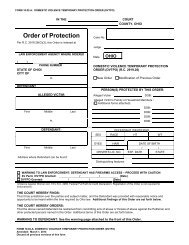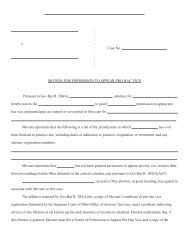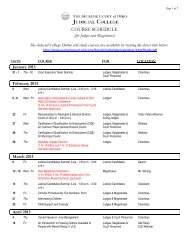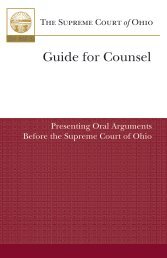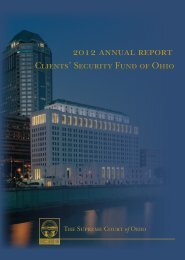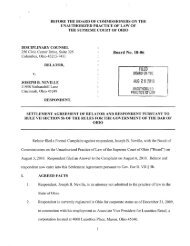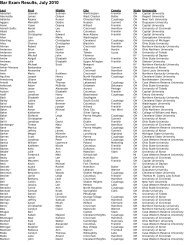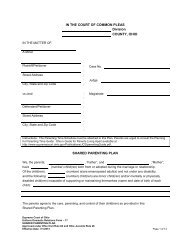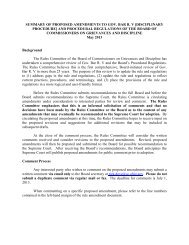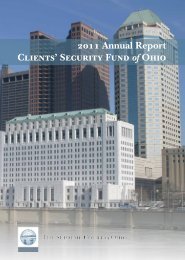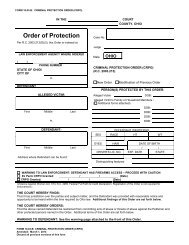Ohio Traffic Rules - Supreme Court
Ohio Traffic Rules - Supreme Court
Ohio Traffic Rules - Supreme Court
You also want an ePaper? Increase the reach of your titles
YUMPU automatically turns print PDFs into web optimized ePapers that Google loves.
OHIO TRAFFIC RULESRule1 Scope of rules; applicability; authority and construction2 Definitions3 Complaint and summons; form; use4 Bail and security5 Joinder of offense and defendants; consolidation for trial; relief from prejudicial joinder6 Summons, warrants: form, service and execution7 Procedure upon failure to appear8 Arraignment9 Jury demand10 Pleas; rights upon plea11 Pleadings and motions before plea and trial: defenses and objections12 Receipt of guilty plea or No Contest Plea13 <strong>Traffic</strong> violations bureau13.1 Juvenile traffic violations bureau14 Magistrates15 Violation of rules16 Judicial conduct17 <strong>Traffic</strong> case scheduling18 Continuances19 Rule of court20 Procedure not otherwise specified21 Forms22 [Reserved]23 Title24 Effective date25 Effective date of amendmentsTemp Temporary provisionMulti-Count Uniform <strong>Traffic</strong> Ticket Commission on the rules of superintendence for<strong>Ohio</strong> courtsUniform <strong>Traffic</strong> Ticket (MUTT)
RULE 1.Scope of <strong>Rules</strong>; Applicability; Authority and Construction(A) Applicability. These rules prescribe the procedure to be followed in all courts ofthis state in traffic cases and supersede the "<strong>Ohio</strong> <strong>Rules</strong> of Practice and Procedure in <strong>Traffic</strong>Cases For All <strong>Court</strong>s Inferior To Common Pleas" effective January 1, 1969, and as amended onJanuary 4, 1971, and December 7, 1972.(B) Authority and construction. These rules are promulgated pursuant to authoritygranted the <strong>Supreme</strong> <strong>Court</strong> by R.C. 2935.17 and 2937.46. They shall be construed and applied tosecure the fair, impartial, speedy and sure administration of justice, simplicity and uniformity inprocedure, and the elimination of unjustifiable expense and delay.[Effective: January 1, 1975.]
RULE 2.DefinitionsAs used in these rules:(A) “<strong>Traffic</strong> case” means any proceeding, other than a proceeding resulting from afelony indictment, that involves one or more violations of a law, ordinance, or regulationgoverning the operation and use of vehicles, conduct of pedestrians in relation to vehicles, orweight, dimension, loads or equipment, or vehicles drawn or moved on highways and bridges.“<strong>Traffic</strong> case” does not include any proceeding that results in a felony indictment.(B) “<strong>Traffic</strong> ticket” means the traffic complaint and summons described in <strong>Traffic</strong>Rule 3 and that appears in the Appendix of Forms.(C)“Highway” includes a street or an alley.(D) “Petty offense” means an offense for which the penalty prescribed by lawincludes confinement for six months or less.(E) “Serious offense” means an offense for which the penalty prescribed by lawincludes confinement for more than six months.(F) “<strong>Court</strong>” means a municipal court, county court, juvenile division of the court ofcommon pleas, or mayor’s court.(G) “Judge” means judge of a municipal court, county court, or juvenile division ofthe court of common pleas, a magistrate of a municipal or county court, or a mayor or mayor’scourt magistrate presiding over a mayor’s court.(H) “Prosecuting attorney” means the attorney general of this state, the prosecutingattorney of a county, the law director, city solicitor, or other officer who prosecutes a criminalcase on behalf of the state or a city, village, township, or other political subdivision, and theassistant or assistants of any of them.(I) “State” means this state, a county, city, village, township, other politicalsubdivision or any other entity of this state that may prosecute a criminal action.(J) “Clerk of court” means the duly elected or appointed clerk of any court of record,or the deputy of any of them, and either the mayor of a municipal corporation having a mayor’scourt or any clerk appointed by the mayor.[Effective: January 1, 1975; amended February 1, 2002; January 1, 2006; January 1,2010.]
<strong>Traffic</strong> <strong>Rules</strong> Review CommissionCommentary (January 1, 2006 Amendment)The amendment deleting the definition of “Review Commission” is made upon transitionof the oversight of the <strong>Ohio</strong> <strong>Traffic</strong> <strong>Rules</strong> from the Review Commission to the Commission onthe <strong>Rules</strong> of Practice and Procedure in <strong>Ohio</strong> <strong>Court</strong>s as adopted by the <strong>Supreme</strong> <strong>Court</strong> of <strong>Ohio</strong>effective January 1, 2006.<strong>Traffic</strong> <strong>Rules</strong> Review CommissionCommentary (February 1, 2002 Amendment)The amendment to the definition of “traffic case” clarifies that the <strong>Ohio</strong> <strong>Traffic</strong> <strong>Rules</strong> donot apply in proceedings that arise from a felony indictment. In traffic cases that arise from afelony indictment, such as felony drunk driving cases, the <strong>Ohio</strong> <strong>Rules</strong> of Criminal Procedurewould apply. See Rule 1(C), <strong>Ohio</strong> <strong>Rules</strong> of Criminal Procedure.The amendment also corrects references to certain courts and makes other nonsubstantivechanges.
RULE 3.Complaint and Summons; Form; Use(A) <strong>Traffic</strong> complaint and summons. In traffic cases, the complaint and summonsshall be the "<strong>Ohio</strong> Uniform <strong>Traffic</strong> Ticket" as set out in the Appendix of Forms.(B) <strong>Traffic</strong> complaint and summons form. The <strong>Ohio</strong> Uniform <strong>Traffic</strong> Ticket shallconsist of four sheets, padded together and bound at the top or bottom edge. Each sheet shall befour and one-fourth inches in width and nine and one-half inches in length from a perforationbelow the binding to the bottom edge. The first sheet shall be white and the second sheet shall becanary yellow. Where an additional copy is needed by an agency, it may be added. The first andsecond sheets shall be at least fifteen pound paper.The first sheet shall be the court record.The second sheet shall be the abstract of court record for the Bureau of Motor Vehicles asrequired by section 4507.021 of the Revised Code. The second sheet may be omitted from theTicket if the court reports violations to the Bureau by electronic or other means acceptable to theBureau.The third sheet shall be the defendant's copy.The fourth sheet shall be the enforcement agency record.A wrap-around may be added to the first sheet. The issuing authority may use the frontand back of the wrap-around for any data or information it may require.Each ticket sheet shall be perforated tab bound at the edge or end with carbon paperinterleaved so that all carbon paper is securely bound to the tab and removable with it, or shall beon treated paper so that marking from the top sheet is transferred legibly to successive sheets inthe group.(C) Use of ticket. The <strong>Ohio</strong> Uniform <strong>Traffic</strong> Ticket shall be used in all moving trafficcases, but its use for parking and equipment violations is optional in each local jurisdiction. Anyticket properly issued by a law enforcement officer shall be accepted for filing and disposition inany court having jurisdiction over the offense alleged. An officer may include more than onealleged violation on a single ticket provided the alleged violations are numbered sequentially onthe face of the ticket. An officer who completes a ticket at the scene of an alleged offense shallnot be required to rewrite or type a new complaint as a condition of filing the ticket, unless theoriginal complaint is illegible or does not state an offense. If a new complaint is executed, a copyshall be served upon defendant as soon as possible.(D) Issuance of tickets to enforcement agency. The judge in a single-judge court,and the administrative judge in multi-judge courts, shall designate the issuing authority for
tickets and prescribe the conditions of issuance and accountability. The issuing authority may bethe clerk of the court, the violations clerk, or the enforcement agency of the municipality.When a single enforcement agency, except the State Highway Patrol, regularly has casesin more than one court, the ticket used by the agency shall be issued through the court for adultsin the most populous area in the jurisdiction of the agency. Tickets used by the State HighwayPatrol shall be issued by the Superintendent of the State Highway Patrol.(E) Duty of law enforcement officer.(1) A law enforcement officer who issues a ticket shall complete and sign the ticket, servea copy of the completed ticket on the defendant, and, without unnecessary delay, file the courtrecord with the court. If the issuing officer personally serves a copy of the completed ticket onthe defendant, the issuing officer shall note the date of personal service on the ticket in the spaceprovided. If the issuing officer is unable to serve a copy of the completed ticket on the defendant,the completed ticket may be served by another law enforcement officer of the law enforcementagency issuing the ticket or filed with the clerk of the court for issuance of a warrant or summonspursuant to Crim. R. 4. Tickets that solely allege one or more minor misdemeanor violationsmust initially be issued by summons.(2) The officer shall notify defendant that if defendant does not appear at the time andplace stated in the citation or comply with division (C) of section 2935.26 of the Revised Code,defendant's license will be cancelled, defendant will not be eligible for the reissuance of thelicense or the issuance of a new license for one year after cancellation, and defendant will besubject to any applicable criminal penalties.(F)Use of Electronically Produced Tickets.(1) Local rules adopted by a court pursuant to the <strong>Supreme</strong> <strong>Court</strong> <strong>Rules</strong> ofSuperintendence for the <strong>Court</strong>s of <strong>Ohio</strong> may provide for the use of a ticket that is produced bycomputer or other electronic means. A ticket produced by computer or other electronic meansshall not require the signature of the defendant. A ticket produced by computer or otherelectronic means shall conform in all substantive respects to the “<strong>Ohio</strong> Uniform <strong>Traffic</strong> Ticket”set forth in the Appendix of Forms. The provisions of division (B) of this rule relative to thecolor and weight of paper, size, and method of binding shall not be applicable to a ticket that isproduced by computer or other electronic means. The ticket paper shall be of sufficient quality toallow the court record copy to remain unchanged for the period of the retention schedule for thevarious traffic offenses as prescribed by Rule 26.05 of the <strong>Rules</strong> of Superintendence for the<strong>Court</strong>s of <strong>Ohio</strong>. The court record of the ticket shall be filed with the court or may be filedelectronically as authorized by local rule and division (F)(2) of this rule.(2) Local rules adopted by a court pursuant to the <strong>Supreme</strong> <strong>Court</strong> <strong>Rules</strong> ofSuperintendence for the <strong>Court</strong>s of <strong>Ohio</strong> may also provide for the filing of the ticket by electronicmeans. If a ticket is issued at the scene of an alleged offense, the local rule shall require that the
issuing officer serve the defendant with the defendant’s paper copy of the ticket as required bydivision (E) of this rule. A law enforcement officer who files a ticket pursuant to divisions (F)(1)or (F)(2) of this rule and electronically affixes the officer’s signature thereto, shall be consideredto have certified the ticket and shall have the same rights, responsibilities, and liabilities as withall other tickets issued pursuant to these rules.[Effective: January 1, 1975; amended effective August 4, 1980; February 26, 1990;November 28, 1990; June 1, 1992, February 1, 2002; October 1, 2006; May 1, 2008;January 1, 2010; January 1, 2014; July 1, 2014.]Staff Note (January 1, 2014 Amendments)The amendments to division (F)(1) and (2) are intended to clarify the signature requirements forthe electronic filing of traffic tickets yet retain the uniform substance of the tickets. Although theamendments make it clear that the signature of the defendant is not necessary, the amendment todivision (F)(2) added language setting forth the law enforcement officer's signature obligation. The phrase"electronically affixes the officer's signature thereto" may include a cursive signature, officer's unit number,or a typed name applied by computer or other electronic means.
<strong>Traffic</strong> <strong>Rules</strong> Review CommissionCommentary (October 1, 2006 Amendment)The October 1, 2006 amendment added language to division (E)(1) to provide analternative means of serving the defendant with a completed traffic ticket. At least one trial courtand three courts of appeal have held that former Traf. R. 3(E) and the Uniform <strong>Traffic</strong> Ticket,when read together, require a law enforcement officer who issues a traffic citation to personallyserve the defendant with a copy of the citation. See Akron v. Detweiler (1978), 54 <strong>Ohio</strong> Misc. 5,6; Oregon v. Fox (Jan. 21, 1983), Lucas App. No. L-82-317; State v. Campbell, 150 <strong>Ohio</strong> App.3d 90, 2002-<strong>Ohio</strong>-6064; and Columbus v. Ford, 2004-<strong>Ohio</strong>-5715. Although personal service iseasily accomplished when a typical traffic citation is issued, compliance is difficult in “hit-skip”cases and other situations where the offender is not cited at the time of the violation or in caseswhere the defendant resides outside the jurisdiction in which the offense occurred.The amendment to division (E)(1) retains the requirement that the issuing officer servethe ticket and, together with the Uniform <strong>Traffic</strong> Ticket, contemplates that service will be madepersonally in the majority of cases by the issuing officer. However, if the issuing officer isunable to personally serve the ticket on the defendant, service may be accomplished throughissuance of a warrant or summons pursuant to Rule 4 of the <strong>Ohio</strong> <strong>Rules</strong> of Criminal Procedure.Commentary (February 1, 2002 Amendment)The February 1, 2002 amendment added division (F) to authorize the use of traffic ticketsthat are produced by computer or other electronic means and the adoption of local rules relativeto the electronic filing of traffic tickets. The intent of division (F)(1) is to retain the uniformsubstance of traffic tickets produced by jurisdictions throughout <strong>Ohio</strong> from the standpoint of thelayout and content of the ticket, but recognize that electronically generated tickets need notcomply with certain requirements applicable to traditional printed forms of traffic tickets. Indeveloping electronic traffic tickets, courts, clerks, and law enforcement agencies should ensurethat the electronic ticket comports as closely as possible to the Uniform <strong>Traffic</strong> Ticket containedin the Appendix of FormsThe amendment to add division (F)(2) is based on a recommendation from the DigitalSignatures Committee of the <strong>Ohio</strong> Judicial Conference. The amendment authorizes the adoptionof local rules, consistent with standards contained in the <strong>Rules</strong> of Superintendence, relative to theelectronic filing of traffic tickets. The amendment requires that the defendant be provided apaper copy of the ticket and states the issuing officer’s responsibility with respect to issuance ofan electronically filed ticket.
<strong>Traffic</strong> <strong>Rules</strong> Review CommissionCommentary (February 1, 2002 Amendment)The February 1, 2002 amendment added division (F) to authorize the use of traffic ticketsthat are produced by computer or other electronic means and the adoption of local rules relativeto the electronic filing of traffic tickets. The intent of division (F)(1) is to retain the uniformsubstance of traffic tickets produced by jurisdictions throughout <strong>Ohio</strong> from the standpoint of thelayout and content of the ticket, but recognize that electronically generated tickets need notcomply with certain requirements applicable to traditional printed forms of traffic tickets. Indeveloping electronic traffic tickets, courts, clerks, and law enforcement agencies should ensurethat the electronic ticket comports as closely as possible to the Uniform <strong>Traffic</strong> Ticket containedin the Appendix of FormsThe amendment to add division (F)(2) is based on a recommendation from the DigitalSignatures Committee of the <strong>Ohio</strong> Judicial Conference. The amendment authorizes the adoptionof local rules, consistent with standards contained in the <strong>Rules</strong> of Superintendence, relative to theelectronic filing of traffic tickets. The amendment requires that the defendant be provided apaper copy of the ticket and states the issuing officer’s responsibility with respect to issuance ofan electronically filed ticket.
RULE 4.Bail and Security(A) Posting of bail; depositing of security. The posting of bail or the depositing ofsecurity is for the purpose of securing appearance or compliance with R.C. 2935.26(C). Theforfeiture of the bail or security may be a substitute for appearance in court, compliance withR.C. 2935.26(C), and payment of penalty imposed on a finding of guilt, with consent of allparties.(B) Bail and security procedure. Criminal Rule 46 governs bail in traffic cases. Inaddition, the provisions of R.C. 2937.221 and R.C. 2935.27 apply in traffic cases.[Effective: January 1, 1975; amended effective August 4, 1980; January 1, 2010.]
RULE 5. Joinder of Offense and Defendants; Consolidation for Trial; Relief[From] Prejudicial JoinderCriminal <strong>Rules</strong> 8, 13 and 14 govern joinder of offenses and defendants, consolidation ofcases for trial and relief from prejudicial joinder in traffic cases.[Effective: January 1, 1975.]
RULE 6.Summons, Warrants: Form, Service and Execution(A) Form. The form of summons and warrants, other than the ticket, shall be asprescribed in Criminal Rule 4.(B) Service and execution. Summons, other than the ticket, and warrants shall beserved and executed as prescribed by Criminal Rule 4.[Effective: January 1, 1975.]
RULE 7.Procedure upon Failure to Appear(A) Issuance of summons, warrant. When a defendant fails to appear pursuant to aticket issued to him, the court shall issue a supplemental summons or warrant.If a supplemental summons is not served or a warrant is not executed within twenty-eightdays of receipt by the serving officer, the court may place the case in a file of cases disposed ofsubject to being reopened. Where bond is forfeited, the disposition shall be reported to theRegistrar of Motor Vehicles. For all other purposes, including disposition reports, the cases shallbe reported as disposed of, subject to being reopened if defendant subsequently appears or isapprehended.(B) Issuance of notice to nonresident. When a nonresident of this state fails toappear pursuant to a supplemental summons or a warrant issued under division (A), the courtmay send by ordinary mail to defendant's address as it appears on the ticket, or the summons orwarrant return, a notice ordering defendant to appear at a specified time and place.If defendant fails to appear or answer within twenty-eight days after the date of mailing ofthe notice, the court shall place the case in the file of cases disposed of subject to being reopened.The mailing of notice in parking cases is discretionary with the court.(C) Effect of waiting periods and bail forfeiture. The waiting period prescribed indivision (A) does not affect forfeiture of bail.If there is a breach of a condition of bail, the court shall declare a forfeiture of bail.Forfeiture proceedings shall be promptly enforced as provided by law.If defendant fails to appear at the time and place specified on the citation and fails tocomply with division (C) of section 2935.26 of the Revised Code, or fails to comply with orsatisfy any judgment of the court within the time allowed, the court shall declare the forfeiture ofdefendant's license. Thirty days after the declaration, the court shall forward a copy of thedeclaration to the Registrar of Motor Vehicles for cancellation in accordance with division (D) ofsection 2935.27 of the Revised Code. If defendant deposits a sum of money or other securitywith the court, the deposit immediately shall be forfeited to the court if he fails to appear orcomply with division (C) of section 2935.26 of the Revised Code.[Effective: January 1, 1975; amended effective August 4, 1980; November 28, 1990.]
RULE 8.Arraignment(A) Arraignment time. Where practicable, every defendant shall be arraigned beforecontested matters are taken up. Trial may be conducted immediately following arraignment.(B) Arraignment procedure. Arraignment shall be conducted in open court andshall consist of reading the complaint to the defendant, or stating to him the substance of thecharge, and calling on him to plead thereto. The defendant shall be given a copy of thecomplaint, or shall acknowledge receipt thereof, before being called upon to plead and may inopen court waive the reading of the complaint.(C) Presence of defendant. The defendant must be present at the arraignment, butthe court may allow the defendant to enter a not guilty plea at the clerk's office in person, by hisattorney in person, or by his attorney by mail, within four days after receipt of the ticket by thedefendant.(D) Explanation of rights. Before calling upon a defendant to plead at arraignmentthe judge shall cause him to be informed and shall determine that defendant knows andunderstands:(1) That he has a right to counsel and the right to a reasonable continuance in theproceedings to secure counsel, and, pursuant to Criminal Rule 44, the right to have counselassigned without cost to himself if he is unable to employ counsel;(2) That he has a right to bail as provided in Rule 4;(3) That he need make no statement at any point in the proceeding; but any statementmade may be used against him;(4) That he has, where such right exists, a right to jury trial and that he must, in pettyoffense cases, make a demand for a jury pursuant to Criminal Rule 23;(5) That if he is convicted a record of the conviction will be sent to the Bureau ofMotor Vehicles and become part of his driving record.(E) Joint arraignment. If there are multiple defendants to be arraigned, the judgemay advise, or cause them to be advised, of their rights by general announcement.[Effective: January 1, 1975.]
RULE 9.Jury Demand(A) Jury demand. Jury demands shall be made pursuant to Criminal Rule 23.(B) Jury demands in mayor's court. Where, in a mayor's court, a defendant isentitled to a jury trial and a jury demand is made pursuant to Criminal Rule 23, the mayor shalltransfer the case pursuant to subdivision (C).If a jury demand is not made pursuant to Criminal Rule 23, and the defendant waives hisright to jury trial in writing, a mayor may try the case if (1) his compensation as a judge is notdirectly dependent upon criminal case convictions, or (2) he is not the chief executive andadministrative officer of the municipality and as such responsible for the financial condition ofthe municipality. Guilty and no contest pleas may be taken by any mayor, including mayorswhose compensation as a judge is directly dependent upon criminal case convictions and mayorswho as chief executive and administrative officer of the municipality are responsible for thefinancial condition of the municipality.(C) Transfer. Where transfer is required, the mayor's court shall make a written orderdirecting the defendant to appear at the transferee court, continuing the same bail, if any, andmaking appearance before the transferee court a condition of bail, if any. Upon transfer, themayor's court shall transmit to the clerk of the transferee court the ticket and all other papers inthe case, and any bail taken in the case.Upon receipt of such papers the clerk of the transferee court shall set the case for trial andshall notify the defendant by ordinary mail of his trial date.[Effective: January 1, 1975.]
RULE 10.Pleas; Rights upon Plea(A) Pleas. A defendant may plead not guilty, guilty or, with the consent of the court,no contest. All pleas may be made orally. If a defendant refuses to plead, the court shall enter aplea of not guilty on behalf of the defendant.(B) Effect of guilty or no contest pleas. With reference to the offense or offenses towhich the plea is entered:(1) The plea of guilty is a complete admission of the defendant's guilt.(2) The plea of no contest is not an admission of defendant's guilt, but is an admissionof the truth of the facts alleged in the complaint and such plea or admission shall not be usedagainst the defendant in any subsequent civil or criminal proceeding.(3) When a plea of guilty or no contest is accepted pursuant to this rule, the courtshall proceed with sentencing under Criminal Rule 32.(C) Misdemeanor cases involving serious offenses. In misdemeanor casesinvolving serious offenses, the court may refuse to accept a plea of guilty or no contest and shallnot accept such plea without first addressing the defendant personally and informing him of theeffect of the pleas of guilty, no contest, and not guilty and determining that he is making the pleavoluntarily. Where the defendant is unrepresented by counsel, the court shall not accept a plea ofguilty or no contest unless the defendant, after being readvised that he has the right to berepresented by retained counsel, or pursuant to Criminal Rule 44 by appointed counsel, waivesthis right.(D) Misdemeanor cases involving petty offenses. In misdemeanor cases involvingpetty offenses, except those processed in a traffic violations bureau, the court may refuse toaccept a plea of guilty or no contest and shall not accept such pleas without first informing thedefendant of the effect of the plea of guilty, no contest, and not guilty. This information may bepresented by general orientation or pronouncement.The counsel provisions of Criminal Rule 44(B), (C) and (D) apply to this subdivision.(E) Refusal of court to accept plea. If the court refuses to accept a plea of guilty orno contest, the court shall enter a plea of not guilty on behalf of the defendant. In such casesneither plea shall be admissible in evidence nor be the subject of comment by the prosecutingattorney or court.
(F) Immediate trial. Upon written consent of defendant and the prosecutingattorney, trial may be conducted immediately after the acceptance of a plea at arraignment. If thedefendant seeks a continuance, or demands a jury trial where such right exists, the court shallcause the case to be set for trial.[Effective: January 1, 1975; amended effective January 1, 2010.]
RULE 11. Pleadings and Motions before Plea and Trial: Defenses andObjections(A) Pleadings and motions. Pleadings in traffic cases shall be the complaint, the pleas of notguilty, guilty, and no contest. Defenses and objections shall be raised before plea and trial bymotion to dismiss or to grant appropriate relief.(B) Motions before plea and trial. Any defense, objection, or request which is capable ofdetermination without the trial of the general issue may be raised before plea or trial by motion.(1) The following defenses and objections must be raised before plea:(a) Defenses and objections based on defects in the institution of the prosecution;(b) Defenses and objections based on defects in the complaint other than failure to showjurisdiction in the court or to charge an offense, which objections shall be noticed by the court atany time during the pendency of the proceeding.(2) The following motions and requests must be made before trial:(a) Motions to suppress evidence, including but not limited to identification testimony, on theground that it was illegally obtained;(b) Requests and motions for discovery under Criminal Rule 16;(c) Motions for severance of charges or defendants under Criminal Rule 14.(C) Motion date. Pre-plea motions shall be made before or at arraignment.All pretrial motions, except as provided in Criminal Rule 16(M), shall be made within thirty-fivedays after arraignment or seven days before trial, whichever is earlier. The court, in the interest ofjustice, may extend the time for making pre-plea or pretrial motions.(D) Disclosure of evidence by prosecuting attorney. At the arraignment, or as soon thereafteras is practicable, the defendant may, in order to raise objections prior to trial under subsection(B)(2), request notice of the prosecuting attorney's intention to use evidence in chief at trial,which evidence the defendant is entitled to discover under Criminal Rule 16.(E) Ruling on motion. A motion made before trial, other than a motion for change of venue,shall be timely determined before trial. Where factual issues are involved in determining amotion, the court shall state its essential findings on the record.(F) Effect of failure to raise defenses or objections. Failure by the defendant to raise defensesor objections or to make motions and requests which must be made prior to plea, trial, or at thetime set by the court pursuant to subdivision (C), or prior to any extension thereof made by the
court, shall constitute waiver thereof, but the court for good cause shown may grant relief fromthe waiver.(G) Effect of plea of no contest. The plea of no contest does not preclude a defendant fromasserting upon appeal that the trial court prejudicially erred in ruling on a pretrial motion,including a pretrial motion to suppress evidence.(H) Effect of determination. If the court grants a motion to dismiss based on a defect in theinstitution of the prosecution or in the complaint, the court shall dismiss the case unless theprosecuting attorney can, pursuant to Criminal Rule 7(D), amend the complaint.(I) State's right of appeal. The state may take an appeal in traffic cases pursuant to CriminalRule 12(K).[Effective: January 1, 1975; amended effective February 1, 2008; amended July 1, 2011.]Commentary (February 1, 2008)The February 1, 2008 amendment to division (I) corrects an inaccurate referencein the previous version of the rule to Criminal Rule 12(J). The previous division (I)expressly limited the state’s right of appeal to two types of cases under <strong>Traffic</strong> Rule13(B)(1) & (3). Such a limitation precluded the state from seeking review of adverserulings on evidentiary matters in all first and second offense OVI cases and, arguablythird OVI case in municipal court. The amendment, in applying the Criminal Rule 12(K)standard, promotes uniformity in addressing the state’s right of appeal in all traffic cases.
RULE 12.Receipt of Guilty or No Contest PleaThe pleas of guilty and no contest shall be received only by personal appearance of thedefendant in open court, except that, the plea of guilty may be received in accordance with Rule13 at a regularly established traffic violations bureau, or by plea in absentia presented in properwritten form with leave of court, and in open court with the prosecutor participating. Pleas inabsentia may be taken on charges involving operation of a motor vehicle in violation of section4511.19 of the Revised Code or any substantially similar municipal ordinance with consent of theprosecutor. The plea in absentia shall contain a rights waiver, acknowledgement of penalties, andthe defendant’s signature.The receipt of a plea contrary to the provisions of these rules is forbidden.[Effective: January 1, 1975; amended effective January 1, 2010.]
RULE 13.<strong>Traffic</strong> Violations Bureau(A) Establishment and operation of traffic violations bureau. Each court shallestablish a traffic violations bureau. The juvenile division of the court of common pleas mayestablish a violations bureau pursuant to <strong>Traffic</strong> Rule 13.1. The court shall appoint its clerk asviolations clerk. If there is no clerk, the court shall appoint any appropriate person of themunicipality or county in which the court sits. The violations bureau and violations clerk shallbe under the direction and control of the court. Fines and costs shall be paid to, receipted by, andaccounted for by the violations clerk.The violations bureau shall accept appearance, waiver of trial, plea of guilty, and paymentof fine and costs for offenses within its authority.(B) Authority of violations bureau. All traffic offenses except those listed in thisdivision may be disposed of by a traffic violations bureau. The following traffic offenses shallnot be processed by a traffic violations bureau:(1) Indictable offenses;abuse;(2) Operating a motor vehicle while under the influence of alcohol or any drug of(3) Leaving the scene of an accident;(4) Driving while under suspension or revocation of a driver's or commercial driver’slicense when jail is a possible penalty;(5) Driving without being licensed to drive when jail is a possible penalty;(6) A third moving traffic offense within a twelve-month period when jail is apossible penalty;(7) Failure to stop and remain standing upon meeting or overtaking a school busstopped on the highway for the purpose of receiving or discharging a school child;(8) Willfully eluding or fleeing a police officer;(9) Drag racing.(C) Schedule of fines. The court shall establish and publish a schedule of fines andcosts for all offenses. The schedule shall be distributed to all law enforcement agenciesoperating within the jurisdiction of the court and shall be prominently displayed at the place inthe violations bureau where fines are paid.
D)(1) Defendant's appearance, plea and waiver of trial. At any time prior toarraignment or thereafter with leave of court, a defendant charged with an offense that can beprocessed by a traffic violations bureau may do either of the following:(a) Appear in person at the traffic violations bureau, sign a plea of guilty and waiverof trial provision of the ticket, and pay the total amount of the fine and costs;(b) Sign the guilty plea and waiver of trial provision of the ticket and mail the ticketand a check, money order, or other approved form of payment for the total amount of the fine andcosts to the traffic violations bureau;(2) A court may establish a procedure for accepting, through its traffic violationsbureau, guilty pleas, waivers of trial, and payments of fines and costs by telephone or otherelectronic means. The form of payment accepted by telephone or other electronic means shall beapproved by the bureau.(3) Remittance of the fine and costs to the traffic violations bureau by any meansother than personal appearance by the defendant at the bureau constitutes a guilty plea and waiverof trial whether or not the guilty plea and waiver of trial provision of the ticket are signed by thedefendant.(E) Records. All cases processed in the violations bureau shall be numbered andrecorded for identification and statistical purposes. In any statistical reports required by law, thenumber of cases disposed of by the violations bureau shall be listed separately from thosedisposed of in open court.(F) Hours of operation; personnel. The court shall appoint a law enforcementofficer as a deputy violations bureau clerk to act as violations clerk when the violations clerk isnot on duty.[Effective: January 1, 1975; amended effective August 4, 1980; February 26, 1990;November 1, 1994; July 1, 1997; May 3, 1999, February 1, 2002; January 1, 2010; July 1,2011; February 1, 2012.]<strong>Traffic</strong> <strong>Rules</strong> Review CommissionCommentary (February 1, 2002 Amendment)The February 1, 2002 amendment to division (A) authorizes the establishment of ajuvenile violations bureau in the court of common pleas. For additional background, see thecommentary accompanying the February 1, 2002 amendment to <strong>Traffic</strong> Rule 13.1.
RULE 13.1. Juvenile <strong>Traffic</strong> Violations Bureau(A) By local rule of court, the juvenile division of the court of common pleas mayestablish a violations bureau for juvenile traffic offenders. Except as provided in division (B) ofthis rule, a juvenile traffic violations bureau shall function in the same manner as a violationsbureau established pursuant to <strong>Traffic</strong> Rule 13.(B)follows:All juvenile traffic offenses may be disposed of by a violations bureau, except as(1) An offense listed in <strong>Traffic</strong> Rule 13(B)(1) to (5) and (7) to (9);(2) A second or subsequent moving offense;(3) An offense that involves an accident.<strong>Traffic</strong> <strong>Rules</strong> Review CommissionCommentary (February 1, 2002 Amendment)In Section 7 of Amended Substitute Senate Bill 179 of the 123 rd General Assembly, theGeneral Assembly recommended that the <strong>Supreme</strong> <strong>Court</strong> authorize the juvenile division of thecourt of common pleas “to create violations bureaus for the payment of tickets that involve firstoffense minor misdemeanor traffic offenses that did not result in an accident.” This ruleimplements this recommendation by allowing juvenile violations bureaus to be created by localrule of court. The rule provides that the procedures established for adult violations bureaus under<strong>Traffic</strong> Rule 13 apply to juvenile violations bureaus and lists offenses committed by a juveniletraffic offender that cannot be disposed of by the bureau.
RULE 14.Magistrates(A) A court may appoint one or more magistrates for the purpose of receiving pleas,determining guilt or innocence, receiving statements in explanation and in mitigation of sentence,and recommending penalty to be imposed. A magistrate shall have been engaged in the practiceof law for at least four years and be in good standing with the <strong>Supreme</strong> <strong>Court</strong> of <strong>Ohio</strong> at the timeof appointment. A magistrate shall be provided with court room accommodations resembling asnearly as possible traffic court rooms.(B) A court may refer nonjury traffic cases to a magistrate. If the offense charged isan offense for which imprisonment is a possible penalty, the case may be referred only with theunanimous consent of the parties, in writing or on the record in open court. The consent of analleged juvenile traffic offender or his or her parent, guardian, or custodian shall not be required.(C) Proceedings before the magistrate shall be conducted as provided in CriminalRule 19. A defendant’s payment of a fine does not constitute a waiver of the defendant’s right tofile objections to the magistrate’s decision.[Effective: January 1, 1975; amended effective September 1, 1996; February 1, 2002;October 1, 2006; July 1, 2011.]<strong>Traffic</strong> <strong>Rules</strong> Review CommissionCommentary (October 1, 2006 Amendment)The October 1, 2006 amendment altered the cross-reference to Criminal Rule 19 toconform to the July 1, 2006 amendments to Criminal Rule 19.Commentary (February 1, 2002 Amendment)The February 1, 2002 amendment conforms the authority of traffic court magistrates tothat of criminal magistrates contained in Criminal Rule 19, as amended effective July 1, 2000.Division (A) retains language of the rule as it existed prior to the amendment and adds that atraffic court magistrate may determine issues of guilt or innocence.Division (B) specifies that any nonjury traffic case, including those involving an allegedjuvenile traffic offender, may be referred to a magistrate, removing any references to the consentof the parties that was contained in the prior rule. In cases where imprisonment, as defined inR.C. 1.05, is a possible penalty, the case may be heard by a magistrate only with the writtenconsent of the parties.
Reference to Civil Rule 53 has been replaced with a requirement that proceedings beforea traffic magistrate will be conducted in accordance with Criminal Rule 19. The rule also statesthat the payment of a fine by the defendant does not constitute a waiver of the defendant’s rightto object to the decision of the magistrate.
RULE 15.[RESERVED]Commentary ( October 1, 2006 Amendment)The October 1, 2006 amendment repealed former Traf. R. 15. Division (A) of that ruleauthorized contempt proceedings before the <strong>Supreme</strong> <strong>Court</strong> against any judge, clerk, or otherpersonnel who willfully failed to apply or adhere to the <strong>Ohio</strong> <strong>Traffic</strong> <strong>Rules</strong>. This provision isdeemed unnecessary since a party may object to or raise on appeal a court’s noncompliance withthe <strong>Ohio</strong> <strong>Traffic</strong> <strong>Rules</strong> or application of local rules that are inconsistent with the <strong>Ohio</strong> <strong>Traffic</strong><strong>Rules</strong>.Division (B) of former Traf. R. 15 authorized the institution of criminal contemptproceedings against any person who improperly disposed of a traffic ticket. This provision isdeemed unnecessary in light of the existence of statutes that would allow for the imposition ofcriminal penalties against a person who improperly disposes of a traffic ticket.
RULE 16.Judicial ConductThe Code of Judicial Conduct as adopted by the <strong>Supreme</strong> <strong>Court</strong> applies to all judges andmayors.It shall be the obligation of each mayor to conduct his court and his professional andpersonal relationships in accordance with the same standards as are required of judges of courtsof record.[Effective: January 1, 1975; amended effective February 1, 2002.]<strong>Traffic</strong> <strong>Rules</strong> Review CommissionCommentary (February 1, 2002 Amendment)The amendment conforms the rule to the Compliance Provision of the Code of JudicialConduct, which specifies that the Code applies to any person, “* * * whether or not a lawyer,who is an officer of a judicial system performing judicial functions * * *.”
RULE 17.<strong>Traffic</strong> Case Scheduling(A) Arraignment and trial by traffic division. Where a court sits in divisions andone division is designated as traffic court, all traffic defendants shall, where practicable, bearraigned and tried in such division.(B) Arraignment and trial by traffic session. Where a court not sitting in separatedivisions designates a particular session as a traffic session, traffic defendants shall, wherepracticable, be arraigned and tried at such session.(C) Single-judge courts. In single-judge courts, traffic cases shall, where practicable, becalled before nontraffic cases. Uncontested traffic cases shall be disposed of first and contestedcases scheduled for later hearing.(D) Single-judge courts. In single-judge courts, traffic cases shall, where practicable,be called before nontraffic cases. Uncontested traffic cases shall be disposed of first andcontested cases scheduled for later hearing.[Effective: January 1, 1975; amended effective January 1, 2010.]
RULE 18.ContinuancesContinuances shall be granted only upon a written motion which states the grounds forthe requested continuance.When a court grants a continuance, it shall set a definite date for the hearing or trial.[Effective: January 1, 1975.]
RULE 19.Rule of <strong>Court</strong>The expression "rule of court" as used in these rules means a rule promulgated by the<strong>Supreme</strong> <strong>Court</strong> or a rule concerning local practice adopted by another court and filed with the<strong>Supreme</strong> <strong>Court</strong>. Local rules shall be supplementary to and consistent with these rules. Eachcourt shall publish its local rules, distribute them within its jurisdiction, and keep copies forinspection.[Effective: January 1, 1975.]
RULE 20.Procedure not Otherwise SpecifiedIf no procedure is specifically prescribed by these rules, the <strong>Rules</strong> of Criminal Procedureand the applicable law apply.[Effective: January 1, 1975.]
RULE 21. FormsThe forms contained in the Appendix of Forms are mandatory, except that additionalcopies of any portions of the ticket may be made. The reverse of the enforcement agency recordshall be in the form prescribed by the issuing authority.[Effective: January 1, 1975.]
RULE 22. [Reserved](Former Rule 22 entitled Review Commission was repealed effective January 1, 2006.The functions of the Review Commission were transferred to the <strong>Supreme</strong> <strong>Court</strong> Commission onthe <strong>Rules</strong> of Practice and Procedure on that date.)
RULE 23.TitleThese rules shall be known as the <strong>Ohio</strong> <strong>Traffic</strong> <strong>Rules</strong> and may be cited as "<strong>Traffic</strong> <strong>Rules</strong>"or "Traf.R. ."[Effective: January 1, 1975.]
RULE 24.Effective Date(A) Effective date of rules. These rules take effect on January 1, 1975. They governall proceedings in actions brought after they take effect, and also all further proceedings inactions then pending, except to the extent that their application in a particular action pendingwhen the rules take effect would not be feasible or would work injustice, in which event theformer procedure applies.(B) Use of tickets conforming to prior rules. <strong>Traffic</strong> tickets conforming to therequirements of the "<strong>Ohio</strong> <strong>Rules</strong> of Practice and Procedure in <strong>Traffic</strong> Cases For All <strong>Court</strong>sInferior to Common Pleas" may be used after the effective date of these rules.After the effective date of these rules, issuing authorities shall order only ticketsconforming to these rules.[Effective: January 1, 1975.]
RULE 25.Effective Date of Amendments(A) The amendments to these rules and the Uniform <strong>Traffic</strong> Ticket adopted by the<strong>Supreme</strong> <strong>Court</strong> of <strong>Ohio</strong> on June 17, 1980 shall take effect on August 4, 1980.(B) The amendments to the Uniform <strong>Traffic</strong> Ticket shall take effect on September 15,1985. The amendment to <strong>Traffic</strong> Rule 22 shall take effect on July 27, 1988.(C) The amendment to <strong>Traffic</strong> Rule 22, adopted by the <strong>Supreme</strong> <strong>Court</strong> on December5, 1989, shall take effect on December 5, 1989.(D) The amendments to <strong>Traffic</strong> <strong>Rules</strong> 3, 13, and 25, and the Uniform <strong>Traffic</strong> Ticket,adopted by the <strong>Supreme</strong> <strong>Court</strong> of <strong>Ohio</strong> on February 13, 1990, shall take effect on February 26,1990.(E) The amendments to <strong>Traffic</strong> <strong>Rules</strong> 3 and 7, adopted by the <strong>Supreme</strong> <strong>Court</strong> of <strong>Ohio</strong>on November 20, 1990, shall take effect on November 28, 1990.(F) The amendments to <strong>Traffic</strong> Rule 3 and to the "Reverse of Defendant's Copy" ofthe Uniform <strong>Traffic</strong> Ticket, adopted by the <strong>Supreme</strong> <strong>Court</strong> of <strong>Ohio</strong> on March 16, 1992, shall takeeffect on June 1, 1992.(G) The amendments to <strong>Traffic</strong> Rule 22, adopted by the <strong>Supreme</strong> <strong>Court</strong> of <strong>Ohio</strong> onAugust 17, 1994, shall take effect on September 19, 1994. The amendments to <strong>Traffic</strong> Rule 13and to the Uniform <strong>Traffic</strong> Ticket, adopted by the <strong>Supreme</strong> <strong>Court</strong> of <strong>Ohio</strong> on August 17, 1994,shall take effect on November 1, 1994.(H) The amendments to <strong>Traffic</strong> Rule 14, adopted by the <strong>Supreme</strong> <strong>Court</strong> of <strong>Ohio</strong> onJuly 10, 1996, shall take effect on September 1, 1996.(I)(1) The amendments to <strong>Traffic</strong> Rule 13, adopted by the <strong>Supreme</strong> <strong>Court</strong> of <strong>Ohio</strong> onMarch 31, 1997, shall take effect on July 1, 1997.(2) The amendments to the Uniform <strong>Traffic</strong> Ticket, adopted by the <strong>Supreme</strong> <strong>Court</strong> of<strong>Ohio</strong> on March 31, 1997, shall take effect on July 1, 1997. Through June 30, 1998, jurisdictionsmay use tickets printed in the format that was authorized prior to July 1, 1997. All ticketsordered for use on or after July 1, 1997 and all tickets used on or after July 1, 1998 shall conformto the format of the July 1, 1997 Uniform <strong>Traffic</strong> Ticket.(J) The amendments to <strong>Traffic</strong> Rule 13, adopted by the <strong>Supreme</strong> <strong>Court</strong> of <strong>Ohio</strong> onMarch 30, 1999, shall take effect on May 3, 1999.(K) The amendments to <strong>Traffic</strong> <strong>Rules</strong> 2, 3, 13, 13.1, 14, 16, and 25, adopted by the<strong>Supreme</strong> <strong>Court</strong> of <strong>Ohio</strong> on December 11, 2001, shall take effect on February 1, 2002.
(L) The amendments to <strong>Traffic</strong> <strong>Rules</strong> 2 and 22, adopted by the <strong>Supreme</strong> <strong>Court</strong> of<strong>Ohio</strong> on October 25, 2005, shall take effect on January 1, 2006.(M) The amendments to <strong>Traffic</strong> <strong>Rules</strong> 3, 14, and 15, adopted by the <strong>Supreme</strong> <strong>Court</strong> of<strong>Ohio</strong> on August 8, 2006, shall take effect on October 1, 2006.(N) The amendments to <strong>Traffic</strong> Rule 11, adopted by the <strong>Supreme</strong> <strong>Court</strong> of <strong>Ohio</strong> onDecember 11, 2007, shall take effect on February 1, 2008.(O) The amendments to <strong>Traffic</strong> Rule 3, adopted by the <strong>Supreme</strong> <strong>Court</strong> of <strong>Ohio</strong> onApril 22, 2008 shall take effect on May 1, 2008.(P) The amendments to <strong>Traffic</strong> <strong>Rules</strong> 2, 3, 4, 10, 12, 13, and 17 and the Uniform<strong>Traffic</strong> Ticket adopted by the <strong>Supreme</strong> <strong>Court</strong> of <strong>Ohio</strong> on September 29, 2009 shall take effect onJanuary 1, 2010. Through June 30, 2010, jurisdictions may use tickets printed in the format thatwas authorized prior to January 1, 2010. All tickets ordered for use on or after July 1, 2010 andall tickets used on or after July 1, 2010 shall conform to the format of the January 1, 2010Uniform <strong>Traffic</strong> Ticket. Correction to the Uniform <strong>Traffic</strong> Ticket adopted by the <strong>Supreme</strong> <strong>Court</strong>of <strong>Ohio</strong> on December 1, 2010 shall take effect on January 1, 2010.(Q) The amendments to <strong>Traffic</strong> <strong>Rules</strong> 11, 13 and 14 adopted by the <strong>Supreme</strong> <strong>Court</strong> of<strong>Ohio</strong> on April 7, 2011 shall take effect on July 1, 2011.(R) The amendment to <strong>Traffic</strong> Rule 13, adopted by the <strong>Supreme</strong> <strong>Court</strong> of <strong>Ohio</strong> onJanuary 3, 2012 shall take effect on February 1, 2012.(S) The amendment to <strong>Traffic</strong> Rule 3, adopted by the <strong>Supreme</strong> <strong>Court</strong> of <strong>Ohio</strong> onDecember 12, 2013, shall take effect on January 1, 2014.(T) The amendment to <strong>Traffic</strong> Rule 3, adopted by the <strong>Supreme</strong> <strong>Court</strong> of <strong>Ohio</strong> on June24, 2014 shall take effect on July 1, 2014.
TEMPORARY PROVISIONNotwithstanding <strong>Traffic</strong> Rule 3, the Bowling Green Municipal <strong>Court</strong> is authorized todevelop and use a modified version of the Uniform <strong>Traffic</strong> Ticket in all moving traffic cases.The modified version of the Uniform <strong>Traffic</strong> Ticket shall be used by the Bowling GreenMunicipal <strong>Court</strong> beginning on a date not later than three months from October 21, 1991 and itsuse shall terminate one year from the date on which it is first used. As used in the <strong>Ohio</strong> <strong>Traffic</strong><strong>Rules</strong> and defined by <strong>Traffic</strong> Rule 2, "traffic ticket" shall include the modified version of theUniform <strong>Traffic</strong> Ticket in all moving traffic developed and used by the Bowling GreenMunicipal <strong>Court</strong> pursuant to this provision.[Effective: October 21, 1991.]
TEMPORARY PROVISIONNotwithstanding <strong>Traffic</strong> Rule 3, the Akron Municipal <strong>Court</strong>, Berea Municipal <strong>Court</strong>,Licking County Municipal <strong>Court</strong>, Newton Falls Municipal <strong>Court</strong>, Parma Municipal <strong>Court</strong>,Brown County <strong>Court</strong>, Broadview Heights Mayor’s <strong>Court</strong>, Moraine Mayor’s <strong>Court</strong>, NorthRoyalton Mayor’s <strong>Court</strong>, and the <strong>Ohio</strong> Highway Patrol are authorized to use the modified versionof the Uniform <strong>Traffic</strong> Ticket approved by the <strong>Supreme</strong> <strong>Court</strong> <strong>Traffic</strong> <strong>Rules</strong> Review Commissionin all moving traffic cases. The modified version of the Uniform <strong>Traffic</strong> Ticket shall be used bythese courts and the Highway Patrol beginning on a date no earlier than April 1, 1996. The useof the modified Uniform <strong>Traffic</strong> Ticket shall continue for a period of six months from the date onwhich it is first used in the individual courts or by the Highway Patrol. As used in the <strong>Ohio</strong><strong>Traffic</strong> <strong>Rules</strong> and defined by <strong>Traffic</strong> Rule 2, “traffic ticket” shall include the modified version ofthe Uniform <strong>Traffic</strong> Ticket used pursuant to this provision.[Effective: April 1, 1996.]
TEMPORARY PROVISIONA law enforcement officer who issues an automated traffic ticket is considered to havesigned the ticket, for purposes of <strong>Traffic</strong> Rule 3(E), if the issuing officer properly authorizes theappearance of his or her facsimile signature on the ticket.For purposes of this Temporary Provision:(A) “Automated traffic ticket” means the computerized traffic citation developed bythe Office of Criminal Justice Services, <strong>Ohio</strong> Highway Patrol, and local law enforcementagencies and courts and being used on a pilot project basis by the Licking County Sheriff’sOffice, Newark Police Department, Heath Police Department, Licking County Municipal <strong>Court</strong>,Circleville Police Department, Pickaway County Sheriff’s Office, Circleville Municipal <strong>Court</strong>,the Circleville Post of the <strong>Ohio</strong> Highway Patrol, the Newark Post of the <strong>Ohio</strong> Highway Patrol,and the General Headquarters of the <strong>Ohio</strong> Highway Patrol.(B) “Properly authorizes” means the issuing officer uses a secure password, in themanner demonstrated to the <strong>Traffic</strong> <strong>Rules</strong> Review Commission at its December 18, 1998meeting, that, when entered, allows an electronic version of the his or her signature to appear onthe automated traffic ticket and on any printed version of that ticket.[Effective: January 12, 1999.]
Uniform <strong>Traffic</strong> Ticket (MUTT)
[Effective: January 1, 2010.]
REVERSE OF ENFORCEMENT AGENCY RECORDCOMMISSION COMMENTARY(July 1, 1997 Amendments)This is the Reverse Side of the Enforcement Agency’s copy of the basic ticket. This sideprovides an information and tracking process for the Enforcement Agency to track court actionon the case and to provide the officer with space for limited notes as to the offense at the time ofcitation, including identification of witnesses. The bottom of the form is to provide informationlocation to the officer for PUCO and weight citations, so that the information may be preserved.



